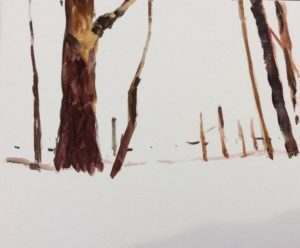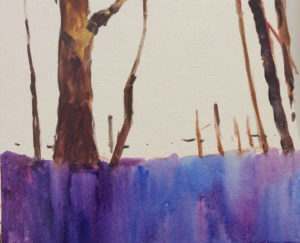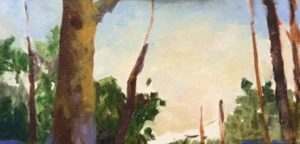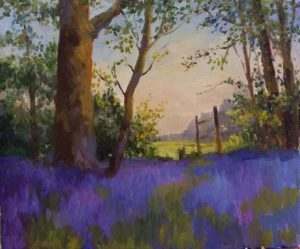
Bluebells:- Either blue can be mixed with Magenta or Violet and White. Ultramarine and Magenta gives a good medium bluebell colour.
Greens:- Any yellow can be mixed with any blue and a little white. Lemon Yellow and Deep Sea Blue will give the brightest spring green. Adding Raw Sienna, or Burnt Sienna, or Violet or Red will give a wide range of greens. Deep Sea Blue, Burnt Sienna and a little Lemon Yellow will give a deep green.
Sap Green can be mixed with Raw Sienna or Burnt Sienna or yellows or blues or Violet.
 The trees were blocked in with a very dilute mix of colours, Burnt Sienna, Raw Sienna and Violet. All this will be adjusted later. At this stage it is better to be too dark. Try to use the dark colours transparently, diluted with turpentine and 5% Stand Oil. The Stand Oil is optional. Apply the oils thinly at this stage rather like a watercolour. The medium will evaporate quite quickly, leaving you with an under-painting which is the foundation for what is to come. It makes the actual painting much easier, if at this stage, you avoid opaque pigments in the mixes, so no White or Yellow Ochre yet. White can make the colour quite slippery and it’s difficult to paint on top of mixes made with a lot of white.
The trees were blocked in with a very dilute mix of colours, Burnt Sienna, Raw Sienna and Violet. All this will be adjusted later. At this stage it is better to be too dark. Try to use the dark colours transparently, diluted with turpentine and 5% Stand Oil. The Stand Oil is optional. Apply the oils thinly at this stage rather like a watercolour. The medium will evaporate quite quickly, leaving you with an under-painting which is the foundation for what is to come. It makes the actual painting much easier, if at this stage, you avoid opaque pigments in the mixes, so no White or Yellow Ochre yet. White can make the colour quite slippery and it’s difficult to paint on top of mixes made with a lot of white.
 You will need a clean brush for the bluebells to keep the colour fresh. The bluebells were painted thinly and vertically, using both blues, French Ultramarine and Deep Sea Blue, mixed with Quinacridone Magenta and Violet in varied mixes, but no white in the mixes yet.
You will need a clean brush for the bluebells to keep the colour fresh. The bluebells were painted thinly and vertically, using both blues, French Ultramarine and Deep Sea Blue, mixed with Quinacridone Magenta and Violet in varied mixes, but no white in the mixes yet.
 You can make a colour for the dark growth with the bluebell colour and Sap Green. That is Sap Green, Blue and Violet or Magenta. Still paint thinly as it’s just a base for what is to come.
You can make a colour for the dark growth with the bluebell colour and Sap Green. That is Sap Green, Blue and Violet or Magenta. Still paint thinly as it’s just a base for what is to come.
 You will need to use a fresh brush and clean medium to mix and paint the sky colours. A lot of times during the painting you can wipe out the brush on a sheet of kitchen roll, but the sky and especially the bluebells need really clean brushes. The sky was painted using both blues mixed with White, Yellow Ochre mixed with White and a touch of Permanent Rose. The paint was diluted with medium to keep it thin, because growth and small branches have to be painted over it. If the sky is too thick at this stage it will be difficult to paint on top.
You will need to use a fresh brush and clean medium to mix and paint the sky colours. A lot of times during the painting you can wipe out the brush on a sheet of kitchen roll, but the sky and especially the bluebells need really clean brushes. The sky was painted using both blues mixed with White, Yellow Ochre mixed with White and a touch of Permanent Rose. The paint was diluted with medium to keep it thin, because growth and small branches have to be painted over it. If the sky is too thick at this stage it will be difficult to paint on top.
 You can start to paint the bluebells. You may need to clean an area of the paletteto mix clean colours. You may need some clean medium and to clean your brush again. Mix several pools of colour on the palette. You won’t need much medium now and may find you don’t need to use any.
You can start to paint the bluebells. You may need to clean an area of the paletteto mix clean colours. You may need some clean medium and to clean your brush again. Mix several pools of colour on the palette. You won’t need much medium now and may find you don’t need to use any.
Ultramarinewith Magenta and White will give you a general bluebell colour, but also mix Ultramarine with Violet and White and Deep Sea Blue with Magenta and White or Deep Sea Blue with Violet and White. Make sure the White is clean because any green, yellow or brown in the brush will destroy the bluebell colour. Try to use a variety of Violet blues, shadows from trees may make bluebells a mix of Deep Sea Blue and Violet, sunshine makes Bluebells more pink, so you could use Magenta and Ultramarine and more White. Be careful at this stage because it is very easy to mush the paint together and lose freshness and vitality in the paint surface.
 Brush marks look quite different if they are applied vertically or horizontally. The colour will look quite different because of how it catches the light. The tree was painted with mixes of Raw Sienna, Burnt Sienna, Violet, Lemon Yellow and Sap Green. Violet was added near the base. Try to keep brush strokes separate and clean. Try different directions of brush strokes, perhaps going around the trunk or you can imply shadows by using diagonal marks. Marks can be softened and blended later if necessary. You have plenty of time.
Brush marks look quite different if they are applied vertically or horizontally. The colour will look quite different because of how it catches the light. The tree was painted with mixes of Raw Sienna, Burnt Sienna, Violet, Lemon Yellow and Sap Green. Violet was added near the base. Try to keep brush strokes separate and clean. Try different directions of brush strokes, perhaps going around the trunk or you can imply shadows by using diagonal marks. Marks can be softened and blended later if necessary. You have plenty of time.
 The distant trees are Violet, White and a little Sap Green which makes the colour more subtle. By now you will have lots of colours on the palette which can be added into leaves or distant colours.
The distant trees are Violet, White and a little Sap Green which makes the colour more subtle. By now you will have lots of colours on the palette which can be added into leaves or distant colours.
The field is Lemon. Moving on to the sunlit greens, Sunflower Yellow is sunshine in a tube. So Sunflower mixed with a very little of either Blue or Sap Green and a little white will give you bright greens. Sap Green can be mixed with Lemon Yellow and a little white too, to give bright greens.
It can be useful to use two brushes, one for dark greens, mixed from Sap Green and Ultramarineor Sap Green and Violet, and use another brush for sunny greens. Twigs and small branches can be painted with a rigger.
 More bluebells and leaves were painted and the gate was highlighted. My painting could go a little further, but I think it is useful to put it away for a week or two before assessing it again. If you want to paint on top after the painting has dried, you can use a little retouching varnish which will bring the colour back to a wet appearance and it will be easier for you to correctly judge the colour matching.
More bluebells and leaves were painted and the gate was highlighted. My painting could go a little further, but I think it is useful to put it away for a week or two before assessing it again. If you want to paint on top after the painting has dried, you can use a little retouching varnish which will bring the colour back to a wet appearance and it will be easier for you to correctly judge the colour matching.